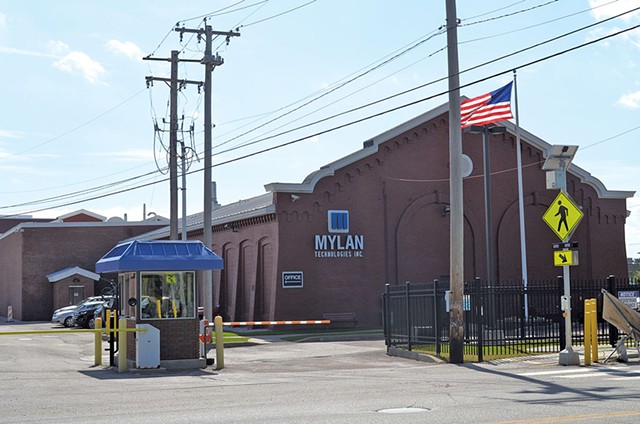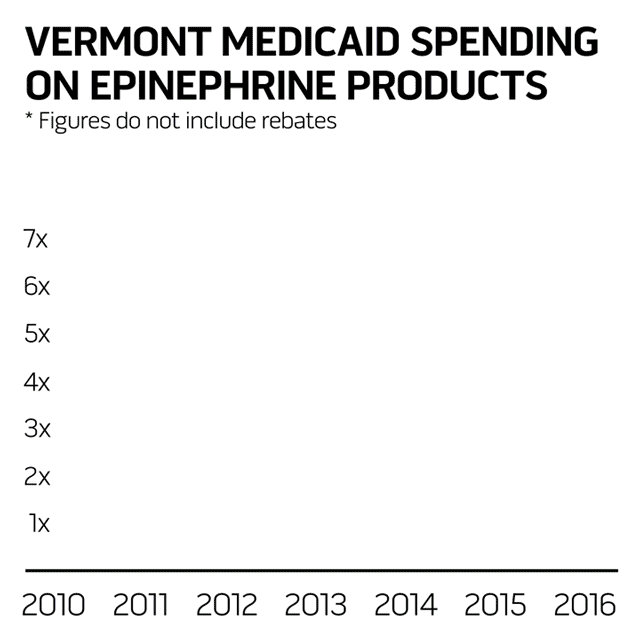
- Alicia Freese
- Mylan in St. Albans
Across the street from a Chinese buffet restaurant in downtown St. Albans, several men in pale blue shirts stood sentry outside a gated brick complex. They were guarding a factory owned by what is likely the most maligned pharmaceutical company in the country at this moment: Mylan. The Pennsylvania-based multinational jacked the prices of its EpiPens last month, sparking an uproar that has turned political.
In Vermont, patients, hospitals, insurers, schools and an already-strained Medicaid program are feeling the effects. Worse, the state provided a large sum of money to subsidize Mylan's St. Albans manufacturing complex, which makes transdermal patches that deliver medicine through the skin.
The Vermont plant doesn't make the EpiPen — a device that automatically injects epinephrine, a hormone that counteracts anaphylactic shock during allergic reactions — but every school is required to have the potentially lifesaving product on hand. When Mylan acquired the EpiPen in 2007, a single auto-injector went for $58. This year, Mylan, which effectively has a monopoly on the device, started selling packs of two for $600.
In an attempt to quell the controversy, Mylan announced August 25 that it would give individual consumers $300 discounts and put a cheaper, generic version on the market. But those concessions have so far failed to quiet intensifying criticism about inordinately high drug prices.
The Vermont Medicaid program spent $256,000 on the devices in fiscal year 2010, or $111 per script, according to data provided by the Department of Vermont Health Access. In fiscal year 2016, it paid five times as much per script — $557 — and spent $1.7 million overall.
Those figures don't tell the full story, because the state gets a cost reduction on the sticker price in the form of a rebate. State health officials can't disclose the amount, according to DVHA's pharmacy director, Nancy Hogue.

Whatever the price break, it isn't enough, according to Rep. Chris Pearson (P-Burlington), who calls the EpiPen scandal "just the latest high-profile example of a really broken system." Drugs cost more in America, he said, "for the simple reason that we're the only country that doesn't negotiate effectively with the pharmaceutical industry."
A lack of transparency around drug prices gives manufacturers the upper hand. Pharmaceutical companies typically defend their prices by claiming they're necessary to defray the cost of developing new drugs. In the case of the EpiPen, Mylan blamed insurers for passing on the costs to consumers. The company does $9.4 billion in annual sales.
Green Mountain Care Board chair Al Gobeille emphasized that "it's not just the EpiPen" putting pressure on health care costs in Vermont. In fact, even with the dramatic price increase, the state's EpiPen bill for Medicaid looks downright modest compared to what it pays for some drugs. Last year, for instance, Seven Days wrote about Orkambi, a cystic fibrosis drug that cost $700 per daily dose, or $259,000 per patient annually. State officials estimated it would cost Medicaid about $8 million this budget year.
The federal government pays the lion's share. Even so, Vermont's portion of Medicaid expenses — $738 million last year and rising — has put serious pressure on the state budget.
In an attempt to do something about rising drug costs — or at least register its dissent — the Vermont legislature passed a law last year directing the Green Mountain Care Board to put together a list of costly prescription drugs that have seen dramatic price increases.
Last month, the state posted that list of 10 drugs online. It doesn't include the actual prices but does document percentage increases over the last five years. Although the EpiPen made the tally, the drug with highest percentage increase is the antibiotic doxycycline hyclate. Its price has increased 4,788 percent.
The new law also requires that drug manufacturers give the Attorney General's Office "a justification for the increase in the wholesale acquisition cost, including all relevant information and supporting documentation." The office will report its findings to the legislature in December, but that information will remain "exempt from public inspection."
Pearson, who has pushed for more stringent legislation, said it's a start: "Let's at least shine a light on this, and, hopefully, other states follow our lead. And then Congress will not be able to ignore the problem."
Price increases hit the entire health care system, not just Medicaid. "The hospitals came into the budget hearings this year, and many of them cited rising pharmaceutical costs as the reason their budgets were over," said Gobeille, who along with the other board members is charged with approving those budgets. "Whenever any one part of the system grows at what I would say is a hyperinflationary rate, it takes money away from other priorities," he noted.
Private insurers are affected, too, along with their premium-paying members.
Cory Gustafson, director of government and public relations for Blue Cross Blue Shield of Vermont, echoed Gobeille, noting that the amount the insurer spends on the EpiPen pales in comparison to payments for drugs such as Humira, an anti-inflammatory drug used to treat rheumatoid arthritis. Humira's monthly list price of more than $4,000 has gone up 130 percent since 2011.
Like other private insurers, Blue Cross Blue Shield doesn't pay that amount. It negotiates lower prices with the drug company through a pharmacy benefits manager, an intermediary with greater purchasing power. As with Medicaid, the discount is confidential.

Such "cost-mitigation measures" can serve as a smoke screen. After Mylan eased the economic pain for its individual customers, Senators Patrick Leahy (D-Vt.) and Bernie Sanders (I-Vt.) signed a letter with colleagues demanding more information. "When patients receive short-term co-pay assistance for expensive drugs, they may be insulated from price hikes," it reads, "but insurance companies, the government and employers still bear the burden of these excessive prices."
Last Friday, Rep. Peter Welch (D-Vt.) and Rep. Tammy Duckworth (D-Ill.) penned their own letter to Rep. Jason Chaffetz (R-Utah), the chair of Oversight and Government Reform Committee, requesting a congressional hearing on the "recent intolerable and inexplicable price increases in the lifesaving EpiPen."
Here in Vermont, the politics are more problematic.
Three years ago, Gov. Peter Shumlin and Mylan CEO Heather Bresch stood side by side in St. Albans to celebrate the completion of Mylan's expanded production center. The state had authorized up to $5.7 million for the company through the Vermont Employment Growth Incentive program, which disburses money in annual installments to businesses if they meet certain growth targets. According to VEGI executive director Fred Kenney, Mylan has received roughly half of the installments, which will continue through 2018 assuming it hits its targets. In late May, WCAX-TV reported that Mylan laid off 60 of its St. Albans employees, which is about 10 percent of its Vermont workforce. But Kenney said that is unlikely to change the amount of money it receives.
At a press conference on August 25, Shumlin, who has received campaign contributions from Mylan, told reporters that the company was "ripping off the American people," according to news reports. In the next breath, he commended it for being "a great employer in Vermont."
Outside the St. Albans facility last Friday afternoon, there were no signs of the EpiPen maelstrom. But there was plenty of evidence of how closely the pharmaceutical company guards information — whether about products or prices.
When a reporter started taking photos outside the complex's eight-foot metal fence, several surly guards approached. They had questions, not answers. Eventually, one of them summoned a company employee who provided a scrap of paper scrawled with Mylan's corporate phone number. A reporter's calls were not returned.





Comments (4)
Showing 1-4 of 4
Comments are closed.
From 2014-2020, Seven Days allowed readers to comment on all stories posted on our website. While we've appreciated the suggestions and insights, right now Seven Days is prioritizing our core mission — producing high-quality, responsible local journalism — over moderating online debates between readers.
To criticize, correct or praise our reporting, please send us a letter to the editor or send us a tip. We’ll check it out and report the results.
Online comments may return when we have better tech tools for managing them. Thanks for reading.